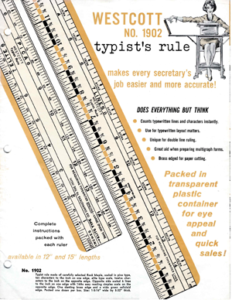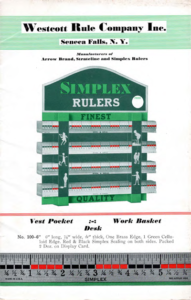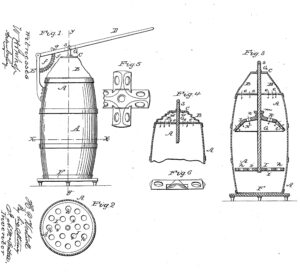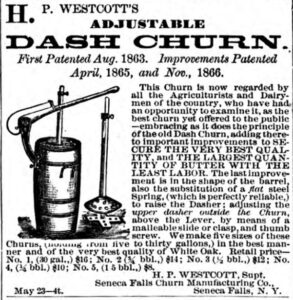 Learners of a certain age knew they could rely on a Westcott Ruler as they scribed margins on their homework or underlined key words in that original composition copied out of an encyclopedia. Whether it was the classic 12-inch wooden rule with the medal edge or the 6-inch model that fit in a pencil box, the Westcott Ruler was standard back-to-school equipment along with the #2 pencil, Big Chief pad and the leaky pens.
Learners of a certain age knew they could rely on a Westcott Ruler as they scribed margins on their homework or underlined key words in that original composition copied out of an encyclopedia. Whether it was the classic 12-inch wooden rule with the medal edge or the 6-inch model that fit in a pencil box, the Westcott Ruler was standard back-to-school equipment along with the #2 pencil, Big Chief pad and the leaky pens.

Westcott Rule Company distributed this 6-inch rule as a seasonal promotion.
For the story behind this famous brand, we turn to a 1992 account by Philip R. Westcott, who was then the manager of the ruler manufacturing plant in Seneca Falls, New York:
The business was founded by my grandfather, Charles Henry Westcott, and his brother Frank. They were assisted in the design and building of equipment by their father, Henry Palmer Westcott, who designed, patented and marketed a new type of churn in 1846 [probably should read 1866].
They began making embossed wooden children’s blocks of various sizes and also embossed mouldings. The mouldings were made from cherry, basswood, etc. and were approximately six inches wide by several feet long. These were embossed with various designs. There are only a few segments remaining.
At this time, the company was also making printers furniture. These are fairly narrow, flat pieces of wood of varying lengths that printers used to provide spacing when setting type and locking up the type in the chase [a steel frame the holds the type]. (I should say “once used” as computers do it now.) At this point the brothers came up with the idea that if they could make printers furniture, they could also print scales on them and have rulers and yardsticks. This was the beginning of the ruler business, and it evolved into the Westcott Rule Company. Prior to that it had been the Westcott Bros. Co.
The business expanded into all types of rulers and yardsticks and all types of measuring devices made from boxwood, maple and basswood initially, and other types of lumber as years went by.
During this period, logs were imported (boxwood) and sawn into lumber, were kiln dried, cut into lengths on a cut-off saw, ripped into the proper thickness on a gang saw, were trimmed to the exact length on a trim saw, and were then put through a sticker or moulder and shaper. After that, they were printed, varnished and a metal edge was inserted. In some cases metal ends were also added.
Later the processing of logs by the Company was given up and they purchased green lumber from local mills. All other operations remained the same.
During the depression in the 30s the company, to augment the reduced sales of rulers and yardsticks, began to manufacture and market venetian blinds. The slats were, of course, made of wood, which was easily turned out on existing equipment. These blinds were very popular, and sales managed to fill the gap until the early 40’s when ruler sales increased to the point where the blinds were gradually phased out. The company was then again solely in the ruler, yardstick, and meterstick business.
Westcott Legacy
The Westcott Family was a driving force in the commercial and industrial development of Seneca County, New York, starting with the arrival of Henry P. Westcott in Seneca Falls in 1847 and continuing with his sons Charles and Frank and their descendants. In addition to making rulers and yard sticks, the family excelled in product development for agriculture and the home market and pioneered many manufacturing techniques. They designed, made and sold churns, butter pails, Venetian blinds, window sashes, moldings, and toys, and the machinery to make all these products in quantity.
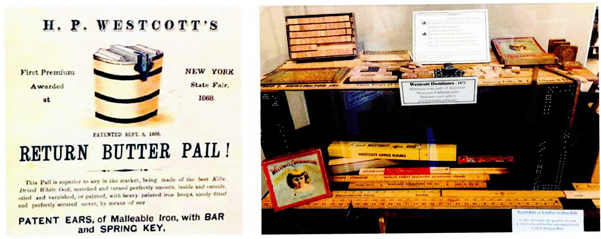
Photographs taken by Kathie Westcot in the Seneca Falls Visitors Center in 2019 show some of the many products made by the Westcotts. Click the butter pail or one of the rulers to see more photos and read an article in the Autumn 2019 Westcott Family Quarterly.
Henry Palmer Westcott (1808-1896)
Henry Palmer Westcott was born on December 11, 1808 in Newport, Rhode Island, the seventh of the fourteen children of Gorton and Waity (Knight) Westcott; he was a descendant of Stukely and Juliana Westcott in the seventh generation: Henry Palmer7 Westcott, Gorton6, Reuben5, Amos4, William3, Jeremiah2, Stukely1. Henry was the brother of Dr. Amos Westcott, “America’s First Dentist,” and the uncle of George Nelson Westcott of Westcott Wrench fame.
Henry was an inventor, a gifted machinist and the leader in the development of Seneca Falls, New York, as a manufacturing center in the 19th century. Said one biographer, “Among the earliest manufacturers of Seneca Falls none was more progressive than … Henry P. Westcott.” Henry learned the sash and blinds trade in Newport and later after the family moved to Truxton, New York, he started his own sash business. By the time he arrived in Seneca Falls, he was already developing machinery for cutting and routing a variety of wood specialties. On January 7, 1862, he secured a patent for “Improvements in Panelling Machines” for routing tongues and grooves and other features with greater precision and speed.
On the same day that Henry received the patent, his brother Amos received a patent of his own for “Improvements in Churns.” Not to be outdone, the following year Henry received the first of three patents for improving the dash butter churn. By 1867, he was marketing H.P. Westcott’s Adjustable Dash Turn, which featured a spring-loaded handle for plunging the dash and an adjustable dasher inside a specially designed churn barrel. He also designed, manufactured and sold a return butter pale. But always ready for new ventures, Westcott sold his butter churn business and turned his attention and manufacturing expertise to helping sons Charles and Frank produce a wide variety of wood products, and carry the Westcott brand into the 20th century. “His death, which occurred on Oct. 29, 1896, at the ripe age of 88 years,” says one biographer, “closed a life of earnest, intelligent work and upright citizenship.”
The Dean of Seneca Manufacturers
As described by Henry’s great-grandson (top of page), the Westcott manufacturing legacy in Seneca Falls continued with Charles and Frank, whose Westcott Bros. Co. and later Westcott Rule Company were major employers in the area. Charles was called the Dean of Seneca Manufacturers in his obituary published on February 25, 1938. The text is transcribed below from a clipping in one of the early albums in the Westcott Society Collection; unfortunately, the newspaper, probably the Seneca County Courier Journal, was not identified.
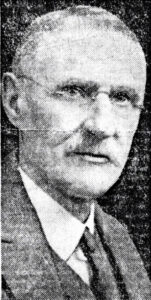 Death Takes C. H. Westcott, Seneca Falls Manufacturer
Death Takes C. H. Westcott, Seneca Falls Manufacturer
One-Man Business He Began Grew To Big Firm
Seneca Falls—Charles H. Westcott, 90, died yesterday in his home, 11 Green St., after a few days’ illness of heart disease. Westcott, dean of Seneca Falls manufacturers and president of the Westcott Rule Company Inc., was active in the business of that company until Saturday, for more than 66 years, being connected with the business from the time of its institution.
He was born Aug. 30, 1848, in this village, the son of Henry P. and Amy Mariette Sloan Westcott. When he was 3 years of age, his parents moved to 11 Green St., where he since has lived. He attended Seneca Falls schools and completed a course of study in Homer Academy in Homer.
Westcott founded the Westcott Rule business at the age of 24 and was its sole operator. He used a building on his father’s property midway between Green and East Bayard Sts. That building is now a part of the Westcot Rule Company Inc., and is used as a shop and composing department. Aided by his father who designed several machines, Westcott and his brother, Frank Westcott, started to manufacturing [sic] wooden furniture for printers and plant trellis units. The firm name Westcott Brothers was used, Charles H. Westcott operated the factory and Frank Westcott was the salesman.
Eight years after the business was started, Westcott began the manufacture of rulers and yardsticks. In 1890 the business was incorporated as Westcott Brothers Inc. In 1894 the corporate title became the Westcott-Jewell Company, with the late C. E. Jewell as an associate. Rulers and yardsticks soon became the predominating product and the business gained a worldwide reputation.
Jewell retired in 1916 and the business title became the Westcott Rule Company Inc. Since 1916 Westcott was president of the company and active daily in the office of the concern.
Westcott was married June 9, 1885 in Canandaigua to Miss Ada S. Palmer of that city. Mrs. Westcott died on July 12, 1936. He was a member of Trinity Episcopal Church and one of the founders of the Citizens’ Club, now extinct. He was a renowned fisherman and built the first cabin along the Cayuga Lake Rd. near Bridgeport. Surviving are his daughter, Miss Alice R. Westcott of this village, a son, Philip R. Westcott, a grandson, Philip R. Westcott Jr. all of Seneca Falls, and a niece Mrs. Henry N. Greig of Tulsa, Okla.
 The Brand Lives On
The Brand Lives On
The Westcott family sold the Westcott Rule Company to Acme United Corporation in 1968. The new owners made sure they maintained the brand and leveraged the name by adding scissors, paper trimmers and other office and craft products to the line.
Sources: Grips Historicals in Archive.com
Hathi Trust Digital Library and Google Books for U.S. Patent Office and Department of Agriculture reports.
Edna Lewis, Westcott Family Tree (see index number 302)
Westcott Family Quarterly, July 2011

